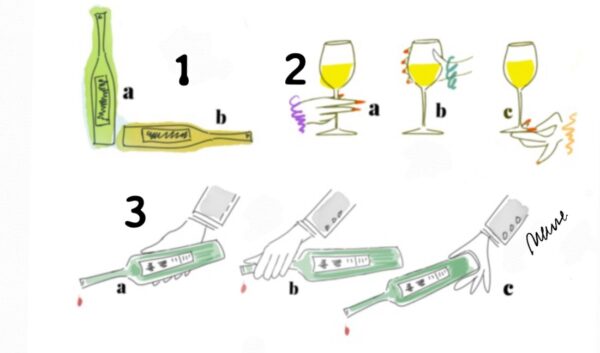
The wine experience is readily sorted into three distinct areas of operations. And, while two of these — the making of wine and its imbibing — draw the bulk of our interest, the third, connected with the keeping, serving and polite consumption of wine, gets far less attention.
What constitutes good behavior in this area is admittedly a contentious subject. So, I’ll make my first observation as non-controversial as I can by pointing out that while some of what we think of as good form in wine has its basis in utility, much of it is purely conventional, meaning we do it this way because . . . well . . . this is the way we do it.
How you may choose to perform any of the maneuvers illustrated above is, of course, entirely up to you But it helps to know what your choices are so that however you opt to proceed, it will at least not be truly outlandish. In this spirit, let’s consider three case studies that ask (and suggest an answer to) the question this way or that?
Case study #1: Shall we store wine in an upright or reclining position?
There are two issues here: First, as red wine spends time in bottle it may generate a sediment. If this happens, you’ll want it to collect it in one place in the bottle so that it’s easier to leave behind as you serve it out. Letting a bottle rest undisturbed in either a vertical or horizontal position will accomplish this, so no particular advantage to either side on that score. Can corks dry out in an upright bottle? Yes, but it takes a long while. This is because the inside of a properly sealed bottle is already quite humid.
Upshot: If your storage conditions are decent and you don’t intend to hold the wine for an extended period, one orientation is probably as good as the other.
Case Study #2: Shall we hold a wine glass by the stem, the bowl or the foot?
There are, so far as I can see, only two issues of utility in play here. The first being that the Bowl Clutch (position b) will alter the temperature of the wine for the warmer. I find this a distinct disadvantage when sipping reds, which are almost always served too warm anyway, and which contact with the human hand can set on a low simmer. It may, however be an advantage when white wine, routinely served too cold, is on offer. Practicalities aside, this doesn’t strike me as a particularly good look aesthetically, resembling as it does the grip generations of New Englanders have used to hoist cans of Narragansett lager.
The Stem Snatch (position a) meanwhile, guarantees that the temperature of your wine will either rise or fall to ambient conditions of its own accord. It offers a second utility benefit of leaving the bowl sparkling clean, despite your fingers having made multiple tours of the raw bar.
The Foot Pinch (c) I find an elegant alternative to a and b, if rather twee. It’s also likely to feel awkwardly top-heavy, until you are well used to it. The trick is to place the thumb firmly atop the foot while the index finger curls supportively beneath. Of course, there’s no way to raise a glass from the table with this technique, so you may have to switch to it once your glass is raised.
Upshot: Position a is always appropriate. Position b much less so, except when you have been issued a stemless glass and thus have no choice in the matter. Position c risks your being mistaken for a Formaggio wine buyer, so step carefully there.
Case study #3: When pouring, shall we hold the wine bottle by neck, barrel or butt?
You will never go wrong or be subject to a snarky critique by employing the time-honored Barrel Hold, a (It may help to think of this as wine service’s missionary position). It’s practical, intuitive, safe and, if not exactly stylish, at least workmanlike.
The Neck Grab (b), in which one appears to choke the bottle is never good form. Though you may have seen a busy bartender resort to it, it’s just not very nice. An exception occurs when you are dealing not with a bottle but a decanter, which, like a swan, is mostly neck and can’t easily be got hold of by other means.
The Bottom Cradle (c) is not recommended without a bit of practice, but when mastered makes for the most polished and pleasing presentation, IMHO. Because of the unfamiliar shift in the center of gravity, it’s easier to execute with a degree of panache when the bottle is less than full. To safely maneuver a full bottle using this advanced technique, slip the tip of the index finger of your free hand under the lip of the bottle to provide a balance point.
Upshot: a if you wish; b if you must; c if you can.